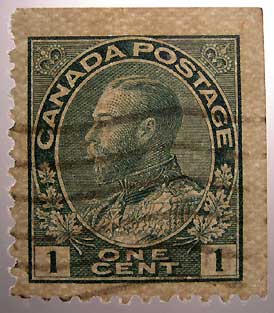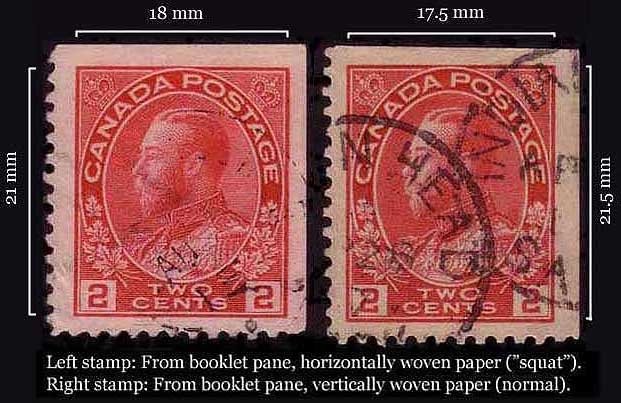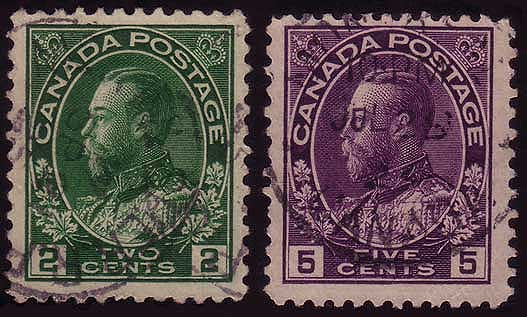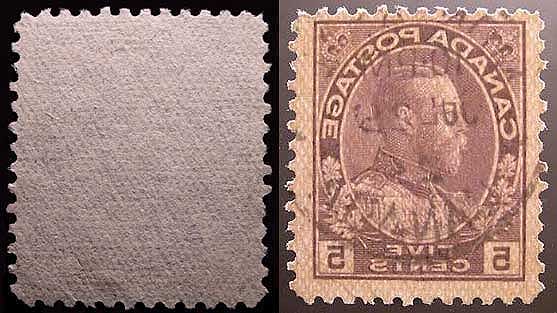Introduction |
Formats |
Printings |
Dies |
Paper |
Straight Edges |
Coils |
Fakes |
Forgeries |
Terminology |
Varieties |
Cancellations |
Rates |
Bibliography
Paper Varieties on the Admirals
The paper used to print the Admirals was machine-made wove paper, generally of medium thickness. For the most part, there are only two significant paper varieties that collectors of this issue should know about.
1. Horizontally Wove Paper
Most Admiral stamps were printed on paper with the grain running vertically ("vertically wove paper"), but a few were printed on horizontally wove paper. The best known are those from the early printings of the 1¢ green and 2¢ carmine booklet panes of six.

Stamps printed on horizontally wove paper are easily identified. The horizontal grain can be seen when the stamp is held up to the light. The 1¢ booklet pane stamp illustrated above was photographed with light shining through from the back to show the horizontal grain of the paper.
In some cases, the horizontally wove paper variety occurred not because of some special property of the paper but rather because of the way the plates were bent to fit on the printing press. Most Admiral plates were bent around a horizontal axis so that the stamps designs were laid out vertically around the circumference of the plate. In contrast, the plates for some early booklet panes were bent around a vertical axis, such that the stamp designs were laid out sideways around the circumference of the plate. In both cases, the paper was fed through the press the same way. The difference in the orientation of the stamp design on the bent plate produced the paper variety.
This difference produced two secondary effects:
- Vertical hairline cracks
- "Squat" stamps
As discussed under plate and printing varieties, the plate bending created stresses that sometimes produced hairline cracks. These cracks run parallel to the axis around which the plates were bent - horizontal for most Admiral stamps, but vertical for the early printings of the booklet panes.
These booklet panes were printed by the wet printing method. Since they were printed on horizontally wove paper, they shrank across the grain and became shorter. Careful measurement will show them to be about half a millimeter shorter than stamps printed on vertically wove paper. Because of this, they are known as "squat" printings.

The illustration above shows two booklet pane stamps printed by the wet method. The stamp on the left is shorter ("squat") because it shrank across the grain of horizontally wove paper, whereas the stamp on the right is narrower because it shrank across the grain of vertically wove paper.
The bending of the plate does not account for all horizontally wove booklet stamps. Some early plates were used on a flatbed press, and were not bent at all. Stamps from these printings are also on horizontally wove paper. In addition, some booklet stamps with horizontal hairlines (implying that the plate used to print them was bent around a horizontal axis) exist on horizontally wove paper.
A few sheet stamps have been reported on horizontally wove paper. The best known is the 10¢ blue. The paper variety comes from a wet printing, so, as might be expected, the stamps are shorter than normal. The 10¢ plates were bent in the normal fashion, so this is a true paper variety. The 2¢ carmine and 2¢ green have also been reported on horizontally wove paper.
2. Thin Paper

In 1924, the 2¢ green and the 5¢ violet Admiral stamps appeared on what is known as "thin paper". While this paper is not much thinner than the normal paper used on the Admirals, it is easily identified by its distinctive mesh. Mesh can be defined as the open spaces in a net or screen; or the threads, cords, etc. forming these openings.

The paper is more translucent than normal, and when held up to a light, the thin spots in the mesh are easily seen as small points of light and the dark spaces between them form a diamond-shaped pattern. This diamond-shaped pattern is often visible on the backs of the stamps without any back lighting. In comparing the illustration above with the one at the top of this page showing a 1¢ booklet pane stamp on horizontally wove paper, one can see how just how translucent this thin paper is.
The 2¢ green and 5¢ violet stamps on thin paper were printed by the wet method. Various sources indicate that they were issued in September or October of 1924. Marler suggests the 5¢ appeared as early as the end of August 1924. However, it must have been at least a month earlier than that because the stamp illustrated above has a dated cancel of July 25, 1924.
Two Admiral stamps, the 2¢ green and 7¢ red brown, have been reported on a thin paper of a different sort. These paper varieties appeared sometime later than the ones described above, and the stamps were printed by the dry method. The mesh of the paper is not distinctive, which makes these varieties harder to identify.
Introduction |
Formats |
Printings |
Dies |
Paper |
Straight Edges |
Coils |
Fakes |
Forgeries |
Terminology |
Varieties |
Cancellations |
Rates |
Bibliography